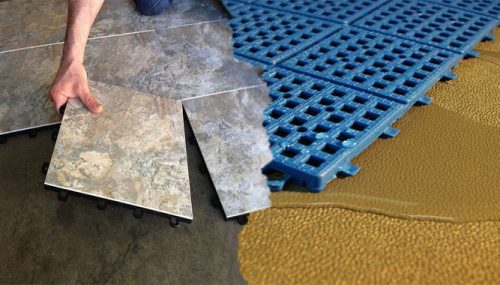Raise your flooring in a wet basement with rubber matting. It offers cushioning for wet basement floors and is ideal for bathrooms, kitchens, and dog kennels. Plus, raised access flooring can dry quickly if a leak occurs. Raised flooring can be installed in any area of your home – basements are ideal locations for wet flooring because of the cement. And, the flooring is easy to maintain and clean, and it can be easily reinstalled when necessary.
Max Tile
A bathroom or gym can benefit from rubber flooring in a wet basement. This flooring is waterproof, mold resistant, and easy to clean. While you should keep up with regular cleaning, minor messes will not require removal of tiles. Occasionally, a floor will become wet, so you will have to adjust the drainage system or remove the tiles and dry the floor before reinstalling the tiles. If this does happen, you can use a power saw to cut a straight line across the tile.
StayLock Tile
There are a number of advantages to installing StayLock Tile raised flooring for wet areas, including its waterproof nature and resistance to oils and acids. It also features various surface options, including orange peel and bump top surfaces. These tiles are easy to install and require no adhesive. And because of their durable construction, they are guaranteed to last for up to 20 years. If you’re considering this type of flooring for your wet basement, you’re in luck.
Vinyl plank flooring
If you’re planning on installing vinyl plank flooring for a wet basement, you should take the floor into consideration. A basement can be anything from a movie room to a home gym. The flooring should be sturdy enough to withstand heavy objects being dropped on it. A good rule of thumb is to keep the heating element at least half an inch away from the vinyl planks to avoid the risk of damage to the flooring.
Ceramic tiles
A raised floor is an excellent choice for a wet basement because ceramic tiles are stain and mold resistant. Ceramic tiles are not susceptible to flooding and should hold up well over time, but a floor must be cleaned regularly to prevent mold from growing. A broom or mop can be used to clean minor spills and messes. If you’re not confident cleaning your wet basement floor yourself, invest in a Swiffer WetJet or SweeperVac.
Rubber mats
The first thing to consider when choosing a new floor for your wet basement is the type of flooring you have in place. If you are considering carpeting, you may want to consider rubber mats, which are waterproof and easily installed over concrete or other hard surfaces. In addition to being waterproof, these mats also provide a safer surface for you and your family to walk on. Luckily, there are a variety of options available to suit every budget and taste.
Floating floors
When it comes to flooring for your wet basement, you can’t go wrong with 100% waterproof vinyl plank flooring. Made of recycled plastic, this type of floor will not crack or be damaged by water. It is also environmentally friendly, as its layers are not exposed to the moisture that causes rot. Another good option for a wet basement is engineered wood flooring, which is made from tongue-and-groove planks with a laminated veneer on top. While floating floors are easy to install, you should watch out for materials made from fiberboard or spongy materials, as these can affect the insulating properties of the flooring.

